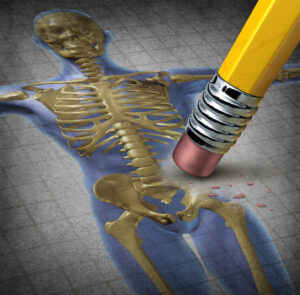 Osteoporosis occurs when bone loss exceeds new bone formation, so you’re at a net loss. Osteoporosis prevention measures such as weight bearing exercises, a healthy diet as described throughout this website, and proper nutritional supplements have been known to help prevent and partially reverse osteoporosis. Lack of exercise, excessive alcohol intake, smoking, chronic “crash” dieting, and nutrient deficiencies are all risk factors. There is never just one cause, and lack of calcium or estrogen is most often not the sole cause. Estrogen accounts for only 15% of bone health. Vitamin D, magnesium, and zinc are extremely important in bone health. Yes, calcium is obviously important too. But look at all the recommendations to take massive 1,500mg or more of daily calcium and the advice to drink milk – yet rates of osteoporosis continue to increase. Yet, in countries where dairy consumption is minimal and supplements are not prescribed, osteoporosis rates are significantly lower. The typical American diet creates a very acidic environment within the body, and that will draw calcium out of the bones.
Osteoporosis occurs when bone loss exceeds new bone formation, so you’re at a net loss. Osteoporosis prevention measures such as weight bearing exercises, a healthy diet as described throughout this website, and proper nutritional supplements have been known to help prevent and partially reverse osteoporosis. Lack of exercise, excessive alcohol intake, smoking, chronic “crash” dieting, and nutrient deficiencies are all risk factors. There is never just one cause, and lack of calcium or estrogen is most often not the sole cause. Estrogen accounts for only 15% of bone health. Vitamin D, magnesium, and zinc are extremely important in bone health. Yes, calcium is obviously important too. But look at all the recommendations to take massive 1,500mg or more of daily calcium and the advice to drink milk – yet rates of osteoporosis continue to increase. Yet, in countries where dairy consumption is minimal and supplements are not prescribed, osteoporosis rates are significantly lower. The typical American diet creates a very acidic environment within the body, and that will draw calcium out of the bones.
Recommending large doses of calcium is not benefiting anyone. Though calcium supplementation is sometimes necessary, not taking into consideration other important nutrients will only throw the biochemical balance off. Clinically, calcium doses over 600mg tend to cause problems such as digestive troubles and back pain in many people. All calcium supplements are not created equal. Calcium carbonate (oyster shell calcium – Tums) is poorly absorbed and not advised. Calcium from dairy is also absorbed at a rate of less than 30%. The best forms of calcium are citrate and lactate. Calcium D-Glucurate is also a very beneficial form of calcium, as it helps detoxify hormones due to the glucuronic acid contained.
Lift Something Heavy!
Calcium and estrogen supplements with a glass of milk aren’t going to cut it when it comes to osteoporosis prevention. Adjust your diet, perform proper exercise, take the nutrients right for you, and stop unhealthy habits such as smoking and drinking soft drinks. Strength exercises are vital if you wish to have strong bones. Lifting, moving, and carrying a heavy weight (done properly!) will keep your bones strong and dense.
Osteopenia
Osteopenia is also very common today. Many women get this diagnosis after having a bone density test done. I do not put much merit into these tests. The bone density values are comparing women to a “normal” 25 year old female. So most women over 50 are told they have low bone density – or osteopenia. Whether they have osteopenia or not, they are all told to take 1500mg of calcium. It’s a bit crazy. Additionally, bone density tests measure the QUANTITY NOT QUALITY of bone – so just because you have a lot, doesn’t necessarily mean it’s healthy.
Drugs & Osteoporosis Prevention and Treatment
The FDA is finally acknowledging that those who use osteoporosis drugs like Fosamax and Boniva are more likely to suffer a fracture of their femur. That’s funny in a not-so-funny way as those drugs are supposed to strengthen bones, not make them weaker. But unfortunately the drugs work by tricking the body into thinking there is healthy bone being made when actually it is not constantly being replaced by new bone – the old bone cells just stay. Back in the spring of 2010 the FDA recognized that proton pump inhibitor drugs such as Aciphex and Prevacid also increase the risk of bone fractures – in the spine, hip, and wrist (probably everywhere, but the study only investigated those areas).
Bones are more than just calcium – which is most often prescribed to women in high doses and poor forms, like calcium carbonate. Bones grow and stay strong from weight bearing exercise, a low acid diet (low sugar, low alcohol, no smoking, healthy fats), and a variety of minerals such as magnesium, zinc, manganese, and many others. Yes, calcium is needed but in a form such as lactate or citrate – not calcium carbonate as commonly found in cheap supplements. Those are great only if you want increase your chances of getting kidney stones. Healthy individuals do not need massive amounts of calcium that are often prescribed – upwards in the 1500mg range. Typically 600 is more than enough, divided into two doses during the day for better absorption. It is those who are unhealthy and their body is too acidic that need more because they are robbing calcium from their bones to help buffer the too acidic state of their blood and tissues. You can read more about acid ash and alkaline ash diets here. Osteoporosis prevention is much easier than dealing with the problem once you’ve got it!




Leave a Reply